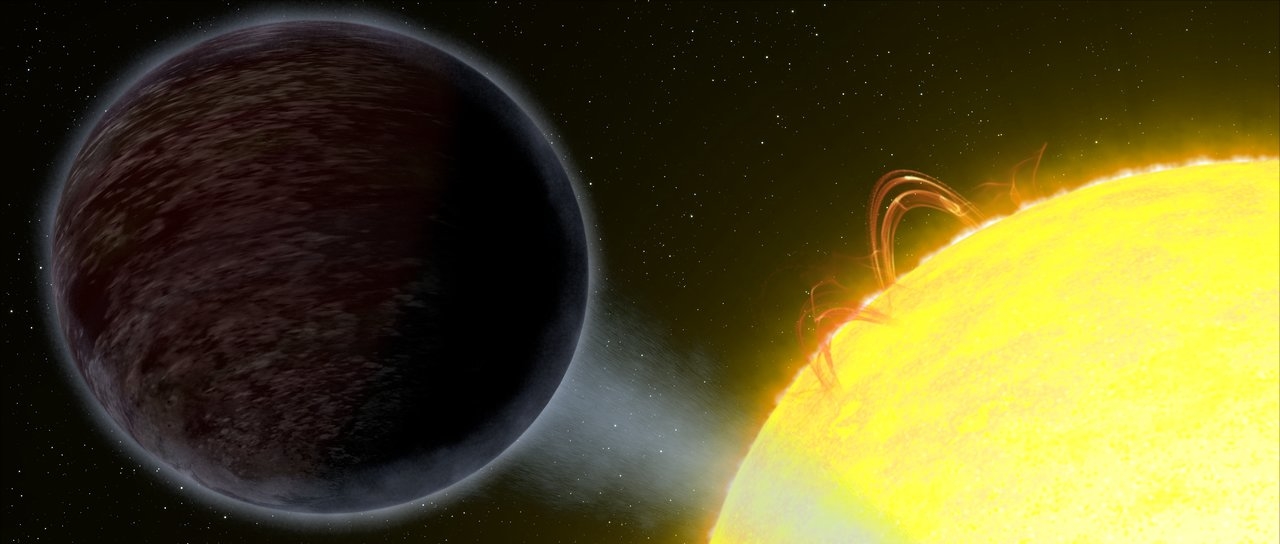The Very Low Albedo of WASP-12b
A Planetary Atmosphere Acting Like a Star

Image Credit: NASA/ESA/G. Bacon
An international team of researchers which I led analyzed new Hubble observations of WASP-12b in hopes of detecting light reflected by the gas giant exoplanet. These observations show that little-to-no light is reflected at optical wavelengths and tell us that the planet would look as dark as fresh asphalt or charcoal, if we could take a look at it. This provides interesting insight into the atmospheric conditions of the exceedingly hot dayside of the planet.
WASP-12b orbits a Sun-like star 400 light years away in the Auriga constellation (near Gemini). Called a hot Jupiter, the roughly Jupiter-mass planet orbits its star once every day, meaning it orbits 20 times closer to its star than Mercury orbits the Sun. The star would take up more than a fifth of your vertical field of view if you were floating in the planet's atmosphere: that's 66 times larger than the Sun appears to us! Because it orbits so close to its host star, the planet has a dayside temperature of 2500 degrees Celsius, which is as hot as a low mass star like Proxima Centauri.
Fans of astronomy and exoplanet research may be familiar with transit observations, where astronomers monitor a star and detect a small dip in the brightness as an exoplanet passes in front of the star and blocks some of the star's light. By observing transits at different wavelengths, researchers can search for changes in the transit depth, which tell us about the composition of the planet's atmosphere near the locations of sunrise and sunset. This method, called transit spectroscopy, was previously used to find water vapour in WASP-12b's atmosphere, a molecule that is commonly found in the atmospheres of gas giant exoplanets. The data also suggested the presence of clouds or hazes in this region of the atmosphere.
A related, and even more difficult, method of studying exoplanets is to observe the miniscule dip in brightness from the star-planet system as the planet passes behind its star; this is called a secondary eclipse. Observing a secondary eclipse can tell you about the reflectivity of the planet if you observe at optical wavelengths or its temperature if you observe at infrared wavelengths. The Hubble Space Telescope observed a secondary eclipse of WASP-12b to search for reflected light across near ultraviolet to green wavelengths. The data showed no such eclipse, which tells us the planet is exceedingly black: at least as dark as a freshly paved road. This non-detection suggests that the planet's atmosphere is so hot that most molecules are unable to survive on the hot dayside of the planet, including hydrogen. Because of this, the dayside of the planet's atmosphere acts more like a M-dwarf (a low-mass star) than a typical hot Jupiter.
Because WASP-12b orbits so close to its star, it is expected to be tidally locked which means it has a permanent dayside and a permanent nightside; this is similar to how the Moon always shows the same face to the Earth. This means that, while the dayside is a scorching 2500 degrees Celsius, the permanently dark half of the planet is a much cooler 1500 degrees Celsius, which allows molecules like H2 and water vapour to form. The drastically different temperatures and compositions of the two halves of WASP-12b are less like day and night halves of a planet, and more like a halves of a low-mass star and a hot Jupiter glued together. This research further demonstrates the vast diversity among the strange population of hot Jupiters.
Other Links
Link to the Journal ArticlePublicly Accesible Link to the Article
STScI Press Release
ESA/Hubble Press Release
NASA Goddard Press Release
iRex Press Release
McGill Press Release